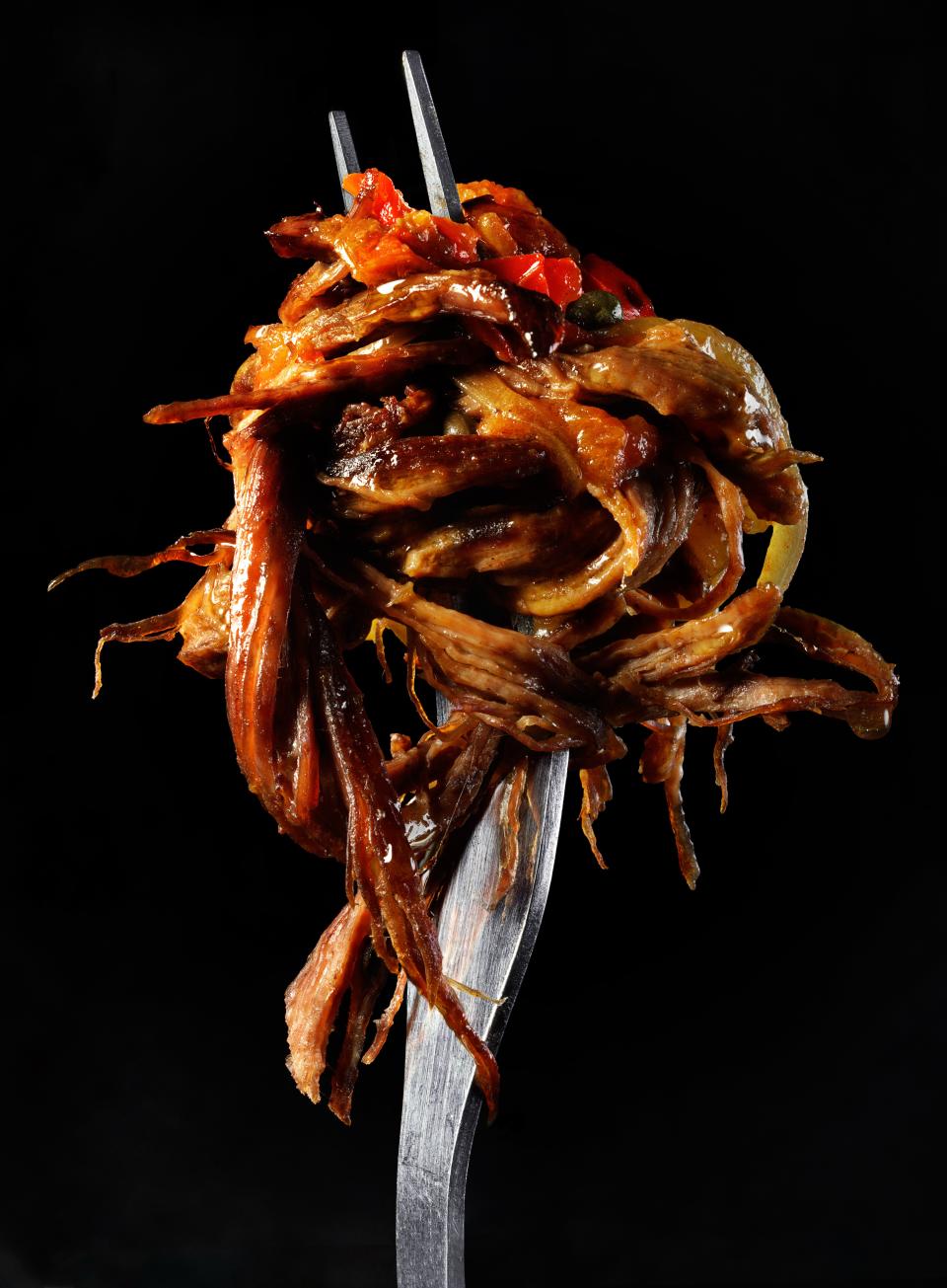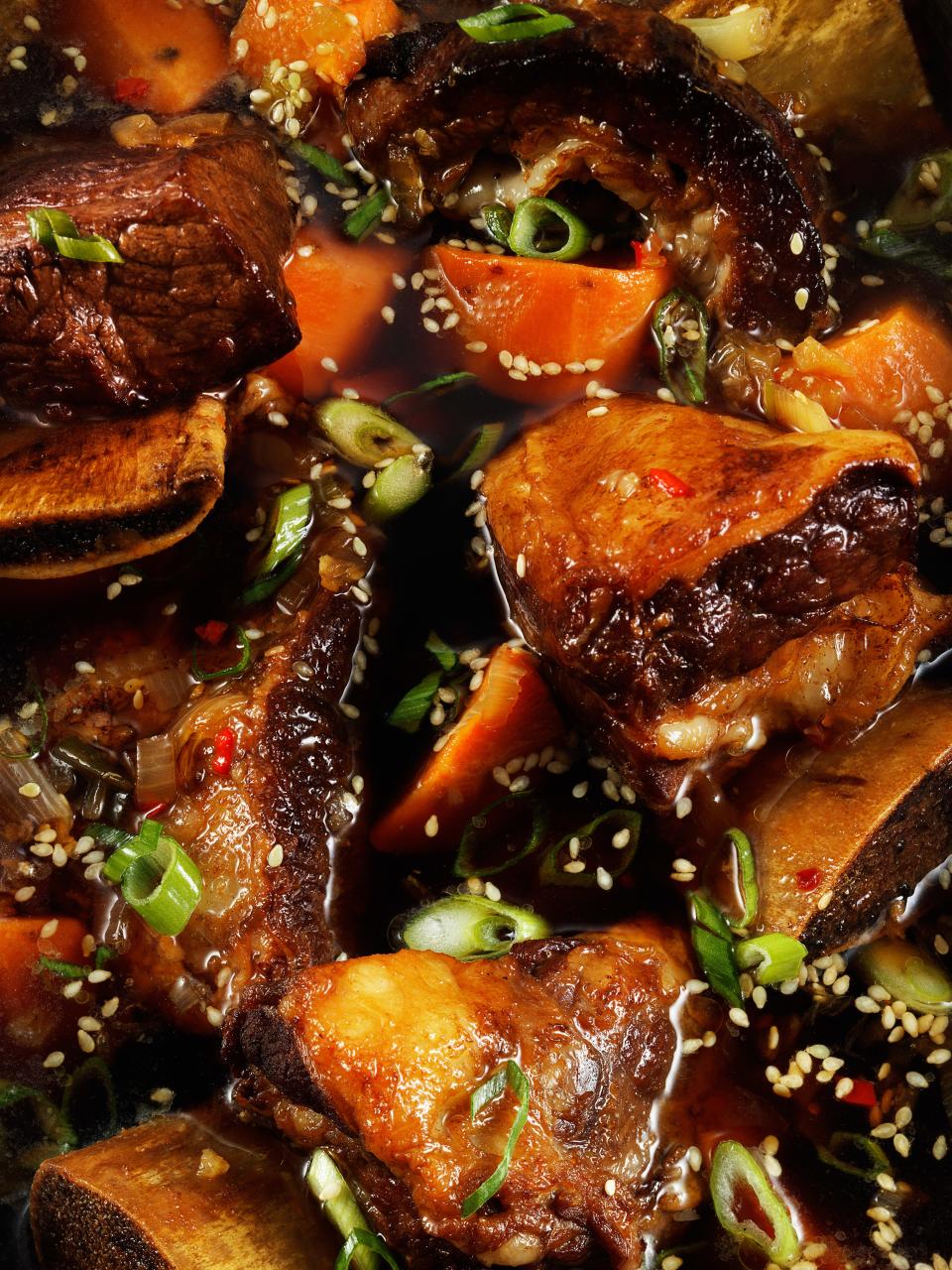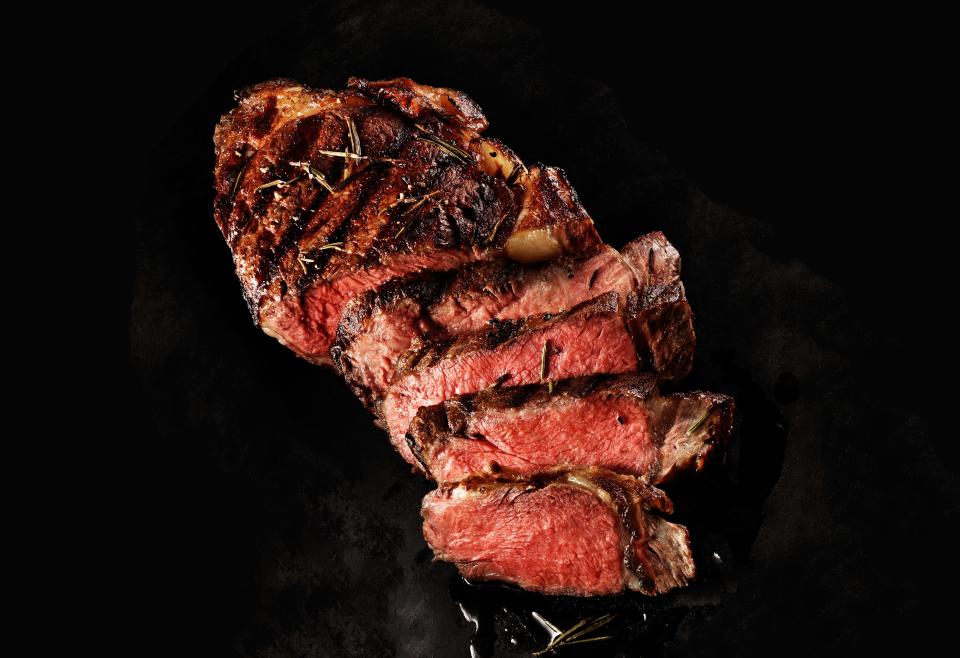The Best Things to Do With a Hunk of Red Meat (Including Eating it Raw)

For the February issue of GQ, we asked our sustainable eating correspondent Mark Bittman to teach us how to eat red meat without, you know, feeling terrible about ourselves—or feeling terrible, physically. You can read all about that here. And if you want to start cooking better meat at home, he's shared four recipes for that grass-fed beef you're gonna go out and buy from your local butcher this weekend.
Beef Tartare
Though it has the veneer of adventurous cooking—serve it as a dinner-party appetizer and guests will gape at your audacity—beef tartare could hardly be simpler. It’s just chopped raw beef spiced as you like. The below is my preference, but you can use anything from Parmesan to hoisin sauce to season the beef, and anchovies are always welcome.
1 pound beef tenderloin, cut into large chunks
1 shallot, peeled and chopped
1 teaspoon Worcestershire sauce
1 teaspoon sherry vinegar
A dash of Tabasco
A fistful of chopped cornichons
1/3 cup capers
2 tablespoons chopped parsley, plus more for garnish
Four small eggs, preferably quail
Place the beef in the container of a food processor (using the regular blade) along with the shallot, Worcesterschire sauce, sherry vinegar, Tabasco, cornichons, and capers. Carefully pulse a tiny bit at a time until the meat is chopped—not ground. Stir in the parsley. Adjust seasoning as you like, then divide among four plates and top each serving with a raw egg and more parsley.

Cuban Beef Stew (a.k.a. ropa vieja)
Ropa vieja, which somewhat unappetizingly translates to “old clothes,” is one of those long-cooked, funky, juicy, tender dishes you can't stop eating. And the only thing even remotely challenging about this Cuban classic is shredding the steaks into the ropey strands that gave the dish its fanciful name. Shredding meat is not difficult, just a bit of an upper-body workout.
2 tablespoons neutral oil, like canola
Salt
2 pounds of halved flank steaks
2 bay leaves
2 onions, one peeled and halved, one peeled and thinly sliced
2 cloves
4 garlic cloves: 2 unpeeled, 2 peeled and minced
2 tablespoons olive oil
1 tablespoon cumin seeds
1 cinnamon stick
2 bell peppers, cored, seeded, and sliced into strips
4 plum tomatoes, chopped
2 tablespoons capers
Cooked rice, for serving
Lime wedges and hot sauce, for garnishing
Season the steaks generously with salt. Pour the oil in a deep, wide skillet or Dutch oven over medium-high heat. Brown the steaks in the pan in two or more batches, coloring the meat deeply on all sides; this should take about 20 minutes total.
Drain the pan and cover the meat with 4 cups water. Stick a clove into each peeled onion half. Crank the heat to high and add bay leaves, onion halves, and unpeeled garlic cloves. When the water boils, partially cover the pan and adjust the heat so the mixture simmers gently. Braise for about 2 hours, or until the meat’s tender.
Remove meat from the pan and transfer to a deep skillet (you want to collect the juices it’ll release). Strain the broth, discarding the aromatics. Reserve 1 cup of broth for this recipe and the rest for another use.
Return the pan to the stove on medium heat and add the olive oil. When it shimmers, add the minced garlic, cumin seeds, cinnamon stick, and sliced onion. Raise the heat and cook, stirring occasionally, until the onions are deeply golden. Add the bell peppers and cook them until they’ve softened slightly. Season well with salt and pepper and add 4 chopped plum tomatoes, reserved broth, and reserved juices. Reduce until half of the liquid in the pan is gone, about 15 minutes.
Meanwhile, shred the beef: Anchor one end of the flank steak with a carving fork and run a second fork the length of the steak, with the grain, shredding it into thin sinewy strips. When you’ve shredded all the beef, stir it into the juices it’s released and add it to the pan and warm through. Garnish with capers and serve with plenty of rice, lime wedges, and hot sauce.

Braised Short Ribs (a.k.a. galbi jjim)
You like that black-sauced, falling-off-the-bone short-rib dish you get in Korean, Japanese, or Chinese restaurants? This is my favorite version. It’s a lot of ingredients, a lot of time, and a bit of work—and it results in one of the world’s great beef braises. Totally worth it.
For the marinade:
8 cloves garlic, peeled and chopped
2/3 cup soy sauce
3 tablespoons sesame oil
3 tablespoons mirin
2 tablespoons sugar
2 tablespoons minced ginger
10 chopped scallions
4 tablespoons toasted and ground sesame seeds
1/2 cup sake
2 fresh chiles, chopped
2 shallots, chopped
1 teaspoon freshly ground black pepper
4 pounds short ribs
To cook the short ribs:
2 tablespoons neutral oil, like canola
3 sweet potatoes, peeled and cut into chunks
2 onions, copped
Kimchi or cabbage slaw, for serving
The night before you plan on cooking your short ribs, combine all the marinade ingredients and the short ribs in an airtight container and refrigerate.
About 2 hours before you’re ready to eat, pour the neutral oil in a broad, deep saucepan and turn the heat to high. Remove the short ribs from the marinade and brown them on all sides, 10 to 15 minutes total. Add the marinade to the meat, along with 1 cup water. Boil, then lower the heat and simmer, covered, for an hour, or until tender.
Turn the heat back to high, uncover the pan, and add the sweet potatoes and onions. Cook at a lively simmer until the stew is thick, the onions soft, and the sweet potatoes tender, 20 to 30 minutes more. Serve with cabbage slaw or kimchi.

Grilled Ribeye
The bigger and thicker your ribeye is, the better it will be and the more people it will serve (but the longer it’ll take to grill). Until you’re a true grillmaster, use an instant-read thermometer to get the very center of the meat to 125 degrees F—that’s medium rare, which is what you want. Well-done is an insult to the cow.
12-ounce boneless, pasture-raised ribeye
Salt and freshly cracked black pepper
Fresh rosemary leaves, removed from the stalk and roughly chopped
Salt your ribeye very well, a few hours in advance if you have the time. Wrap it in cotton or paper towels to absorb excess liquid. Get your grill as hot as it’ll go, and keep it covered. When you’re ready to cook, shut off the gas under one part of the grill, or bank the coals over to one side. Press plenty of pepper into the meat, along with some rosemary. Grill the meat, covered, over the less-hot part of the grill, but as close to the hot part as you can make it without the meat catching fire. Turn after 2 minutes, when the underside is nicely browned. Test for doneness after 4 minutes and cook a little longer if necessary. Rest for a couple of minutes before carving, then serve.

